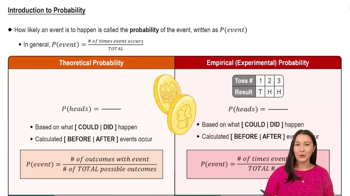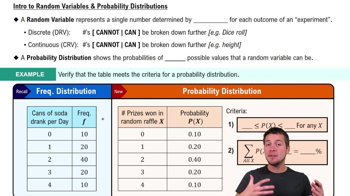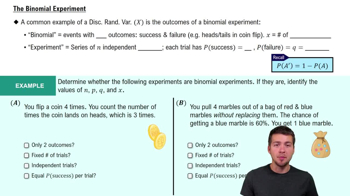2. Determine whether each number could represent the probability of an event. Explain your reasoning. d. -0.0004
Table of contents
- 1. Intro to Stats and Collecting Data1h 14m
- 2. Describing Data with Tables and Graphs1h 55m
- 3. Describing Data Numerically2h 5m
- 4. Probability2h 16m
- 5. Binomial Distribution & Discrete Random Variables3h 6m
- 6. Normal Distribution and Continuous Random Variables2h 11m
- 7. Sampling Distributions & Confidence Intervals: Mean3h 23m
- Sampling Distribution of the Sample Mean and Central Limit Theorem19m
- Distribution of Sample Mean - Excel23m
- Introduction to Confidence Intervals15m
- Confidence Intervals for Population Mean1h 18m
- Determining the Minimum Sample Size Required12m
- Finding Probabilities and T Critical Values - Excel28m
- Confidence Intervals for Population Means - Excel25m
- 8. Sampling Distributions & Confidence Intervals: Proportion1h 25m
- 9. Hypothesis Testing for One Sample3h 29m
- 10. Hypothesis Testing for Two Samples4h 50m
- Two Proportions1h 13m
- Two Proportions Hypothesis Test - Excel28m
- Two Means - Unknown, Unequal Variance1h 3m
- Two Means - Unknown Variances Hypothesis Test - Excel12m
- Two Means - Unknown, Equal Variance15m
- Two Means - Unknown, Equal Variances Hypothesis Test - Excel9m
- Two Means - Known Variance12m
- Two Means - Sigma Known Hypothesis Test - Excel21m
- Two Means - Matched Pairs (Dependent Samples)42m
- Matched Pairs Hypothesis Test - Excel12m
- 11. Correlation1h 6m
- 12. Regression1h 50m
- 13. Chi-Square Tests & Goodness of Fit1h 57m
- 14. ANOVA1h 57m
4. Probability
Basic Concepts of Probability
Problem 3.1.14
Textbook Question
Matching Probabilities In Exercises 11-16, match the event with its probability.
a. 0.95
b. 0.005
c. 0.25
d. 0
e. 0.375
f. 0.5
14. A game show contestant must randomly select a door. One door doubles her money while the other three doors leave her with no winnings. What is the probability she selects the
door that doubles her money?
 Verified step by step guidance
Verified step by step guidance1
Step 1: Understand the problem. The contestant is choosing randomly among four doors, where only one door doubles her money, and the other three result in no winnings. This is a classic probability problem involving equally likely outcomes.
Step 2: Recall the formula for probability of an event. The probability of an event occurring is given by the formula: P(Event) = (Number of favorable outcomes) / (Total number of possible outcomes).
Step 3: Identify the favorable outcomes. In this case, the favorable outcome is selecting the one door that doubles her money. So, the number of favorable outcomes is 1.
Step 4: Identify the total number of possible outcomes. Since there are four doors in total, the total number of possible outcomes is 4.
Step 5: Substitute the values into the probability formula. Using the formula P(Event) = (Number of favorable outcomes) / (Total number of possible outcomes), substitute 1 for the number of favorable outcomes and 4 for the total number of possible outcomes. This gives P(Event) = 1/4.
 Verified video answer for a similar problem:
Verified video answer for a similar problem:This video solution was recommended by our tutors as helpful for the problem above
Video duration:
1mPlay a video:
Was this helpful?
Key Concepts
Here are the essential concepts you must grasp in order to answer the question correctly.
Probability
Probability is a measure of the likelihood that an event will occur, expressed as a number between 0 and 1. A probability of 0 indicates an impossible event, while a probability of 1 indicates a certain event. In this context, the probability of selecting the winning door can be calculated by dividing the number of favorable outcomes by the total number of possible outcomes.
Recommended video:

Introduction to Probability
Random Selection
Random selection refers to the process of choosing an item or outcome from a set in such a way that each item has an equal chance of being selected. In the game show scenario, the contestant randomly selects one of four doors, meaning each door has an equal probability of being chosen, which is crucial for determining the probability of winning.
Recommended video:
Guided course

Intro to Random Variables & Probability Distributions
Favorable Outcomes
Favorable outcomes are the specific results in a probability scenario that lead to a successful event. In the case of the game show, there is one favorable outcome (selecting the door that doubles the money) out of four possible outcomes (the four doors). Understanding favorable outcomes is essential for calculating the overall probability of an event.
Recommended video:
Guided course

The Binomial Experiment

 5:37m
5:37mWatch next
Master Introduction to Probability with a bite sized video explanation from Patrick
Start learningRelated Videos
Related Practice
Textbook Question
